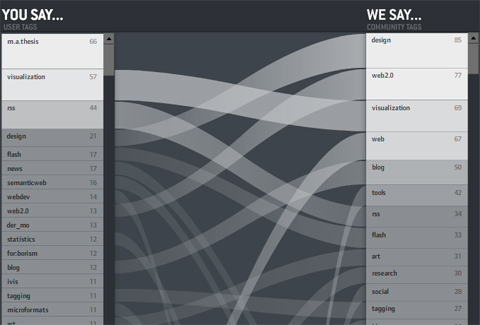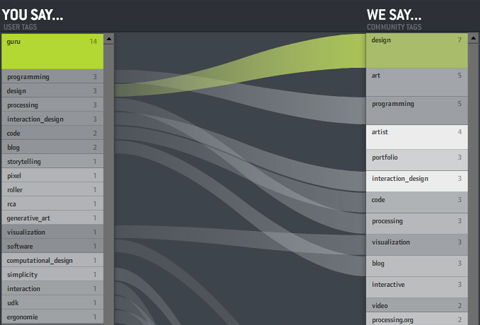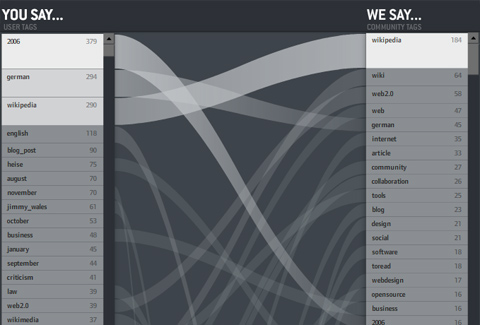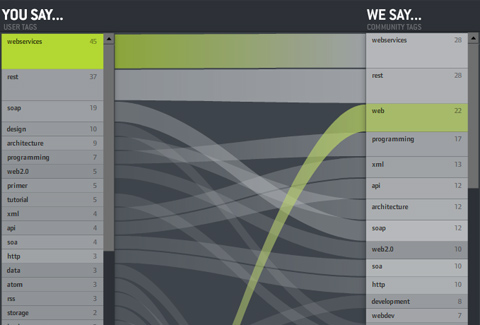You say… We say…
Another visual experiment on tagging:
How do individuals use tags — compared to the community? Do you use private language or are you a mainstream tagger? When you tag with “design” — do the others think it is “art”?

On the left: the personal tags for the personal bookmarks — ordered by frequency — the containing box per is log-scaled so you get an impression of the long–tail position of a tag. Which means: Often used tags are large, bright and go to the top.
On the right: community tags for the tagged ressources.
In the middle: tags with the same name are connected. If a line is horizontal, the indvidual and the community essentially agree on the relevance of the tag for the ressources. The steeper it is — the larger the disagreement. If no line starts at a tag, it means it is not present in the other list
So in the picture above, you can see my tags. Same facts you can read from the picture:
• “m.a.thesis” is a very often used, but private tag of mine.
• The ressources I tag in general are mostly tagged with “design” by the community. I, however, use the tag “design” much less often.
• “news”, “semantic web”, “webdev” are tags I use often, but not the community.
etc.

And often course, you can click individual tags to see what the comparison is like for subsets of the bookmarks. That’s especially interesting for obscure tags like “guru” — you can see what the tagger “means” by looking at the distribution of the community bookmarks (in this case “design – art – programmer – artist”). Interesting!
Some more shots:


I wish I could say “click here for the interactive version” as usual — but unfortunately, del.icio.us offers a JSON API, but did not put a crossdomain.xml file on their server. Which means the visualization (which runs nicely on my harddisc) cannot load data when put in the web. Bummer. I hope I can figure something out.
So for now — I can only offer a download link. Click the index.html. You might have to adjust you Flash player security settings in order to load the community tags. Caveat: The application is still a bit buggy and pretty heavy concerning processor ressources.
May 10th, 2007 at 10:54 pm
interesting – as usual. unfortunately the downloaded application doesn’t work. anytime i want to change the settings of flash-player it starts getting weird. the settings dialogue is blinking and i can’t change anything.
anyway, some awful new thoughts by you. and i am still thinking about acoustics methods of this whole thing.
May 11th, 2007 at 12:31 am
Very interesting. Was it an intentional irony that you did not tag this blog posting?
May 11th, 2007 at 2:27 am
[…] You say… We say… Another visual experiment on tagging: How do individuals use tags compared to the community? Do you use private language or are you a mainstream tagger? When you tag with “design” do the others think it is “art”? (tags: tag name visualization) […]
May 11th, 2007 at 9:08 am
Thanks — no intention with the missing tags, my plugin is somehow broken. The tags keep appearing and disappearing.
May 11th, 2007 at 12:07 pm
Very interesting and neat. Do post in the app if you can get it running. It conked off on my system.
May 12th, 2007 at 1:28 am
[…] Well-formed data » You say… We say… (tags: visualization tagging folksonomy metadata tags) […]
May 13th, 2007 at 8:57 pm
[…] Nad sent me a link to a neat tag visualisation by Moritz Stefaner. tagging web web2.0 […]
May 14th, 2007 at 9:46 am
Great work, as usual. Thanks for sharing the download.
Just a note for anyone on OS X: I couldn’t get the security settings swf to run in Safari, but Firefox runs the security settings page no problem and then it’s possible to load the movie.
I think it’s an issue with Adobe’s security movie and not with “YouSayWeSay2.”
June 27th, 2007 at 2:22 pm
a simple proxy might help. simply have a local php script (or any other language) that acts as a proxy between your flash app and the site. the flash app asks the local php script for an xml file which is then contructed through the json api which the php script can access.
June 29th, 2007 at 11:21 pm
Hi, thanks Tijs, thought of this as well. The problem here is that all visitors have to go through the same proxy, which together with the one-request-per-second policy of delicious will be quite a bottleneck. Anyways, I guess that’s the solution I should go for, if nothing changes!
September 7th, 2007 at 4:51 am
[…] You Say – We Say http://well-formed-data.net/archives/72/you-say-we-say […]
September 21st, 2007 at 10:12 am
[…] topics updateYou say… We say…Visualization and Aesthetics ResearchThesis presentationVisual tools for the socio–semantic webTag […]
October 12th, 2007 at 1:23 pm
[…] Well-formed data » You say… We say… How do individuals use tags — compared to the community? Do you use private language or are you a mainstream tagger? When you tag with “design” — do the others think it is “art”? (tags: tagging visualization flash research facets comparison tag folksonomy cool folksonomies group ideas inspiration) […]
October 13th, 2007 at 9:21 pm
[…] Well-formed data » You say… We say… (tags: well-formed-data.net 2007 mes9 dia13 flash tagging) […]
November 27th, 2007 at 4:08 pm
[…] tool l’ha chiamato “You say… We say…” per il momento non è disponibile sul web ma scaricabile e soprattutto da […]
January 28th, 2008 at 12:30 am
[…] You Say We Say This project is a visual experiment in tagging. On the left you get the personal tags for the personal bookmarks ordered by frequency, and the containing box per is log-scaled so you get an impression of the long-tail position of a tag. Which means that often used tags are large, bright and go to the top. On the right are the community tags for the tagged resources. In the middle the tags with the same name are connected. If a line is horizontal, the indvidual and the community essentially agree on the relevance of the tag for the ressources. The steeper it is the larger the disagreement. If no line starts at a tag, it means it is not present in the other list. Very fascinating construct for tagging. […]
April 15th, 2008 at 10:31 pm
[…] well formed data […]
June 2nd, 2009 at 8:22 am
[…] You Say We Say This project is a visual experiment in tagging. On the left you get the personal tags for the personal bookmarks ordered by frequency, and the containing box per is log-scaled so you get an impression of the long-tail position of a tag. Which means that often used tags are large, bright and go to the top. On the right are the community tags for the tagged resources. In the middle the tags with the same name are connected. If a line is horizontal, the indvidual and the community essentially agree on the relevance of the tag for the ressources. The steeper it is the larger the disagreement. If no line starts at a tag, it means it is not present in the other list. Very fascinating construct for tagging. […]
April 22nd, 2014 at 11:08 pm
Fixed a bug where a kill from troop trap gave the wrong
message. Battlefield Heroes is founded on a
great idea: Let the customer pay real money to create an individual avatar.
“See Wang Yu Yan hole to the foot of his confront, embarrassed and then hesitated, and prayed and claimed: “Prince so courteous, well Jen is inclined to influence pleasures of the staff.